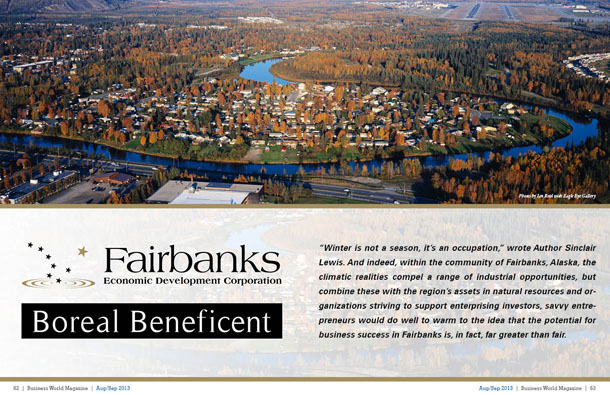
“Winter is not a season, it’s an occupation,†wrote Author Sinclair Lewis. And indeed, within the community of Fairbanks, Alaska, the climatic realities compel a range of industrial opportunities, but combine these with the region’s assets in natural resources and organizations striving to support enterprising investors, savvy entrepreneurs would do well to warm to the idea that the potential for business success in Fairbanks is, in fact, far greater than fair.
Beyond its distinction as the second most densely populated region of Alaska, Fairbanks is the northernmost Metropolitan Statistical Area of the United States and is only some 120 miles south of the Arctic Circle (that’s a little more than a day’s travel by dog sled). Located in the central Tanana Valley, Fairbanks emerged from the site of a trading post Elbridge Barnette established along the Chena River, a waterway that winds below a chain of hills that ultimately give rise to the White Mountains, which have been more historically-hyped for their golden hue. Beyond its fostering of gold fever, Fairbanks is famed as the land of the midnight sun and being home to luminary phenomenon born of the aurora borealis. Though the gold rush has long gone and winter degrees are just as daunting as they’ve ever been, Fairbanks and its affiliate North Star Borough still beckons as a beacon of opportunity for business leaders, and that’s a point eloquently articulated by Jim Dodson, a lifelong resident of Fairbanks who also serves as the president and chief executive officer of the Fairbanks Economic Development Corporation.
“Here in Alaska, keep in mind, that we have 700,000 people living among 570,000 square miles, that amounts to a little bit more than one person per square mile … and more than half of the state’s entire population lives either in Anchorage or Fairbanks,†explains Dodson. As Fairbanks is a hub for 43 other, smaller communities, Dodson’s office additionally works with (and for) entrepreneurs in these areas, helping them better understand how to do business in rural Alaska. While the population numbers alone pose opportunities for a diverse mix of retailers looking to connect with a captive audience of consumers, Dodson says the diversity of land also sets Fairbanks apart from other areas. “From islands to federal land and native lands, the mix poses unique economic challenges and unique opportunities,†says Dodson.
Energized Excellence
Challenges and opportunities both play out in efforts to capitalize on the region’s greatest assets; which as Dodson affirms, “From timber and fish to minerals and oil … we’re rich with resources.â€
To his point, consider the area known as the North Slope. This region that encompasses Alaska’s National Petroleum Reserve contains the bulk of the known petroleum in the state. Yet, beyond the reserve, other discoveries have been made in an area known as the Prudhoe Bay Oil Field. A 2012 U.S. Geological survey surmised this area could yield as much as two billion barrels of oil and as much as 80 trillion cubic feet of natural gas.
Dodson says while so much of the minerals and petroleum mined from the region is expeditiously exported, part of his office’s mission has been to support and encourage growth of a value-added economy. For instance, in recent years, Fairbanks has seen two new refineries develop and these are now supplying a large percentage of jet fuel and auto fuel. Quite similar to the consensus on Alaska’s petroleum deposits; Dodson says the range of professional opportunities in this industry segment have yet to be tapped. However, Fairbank’s energy industry is helping to foster growth of other industries. For example, Fairbanks-based Lifewater Engineering Company is a firm specializing in the development of water treatment systems that can function under the most extreme of environmental conditions. Lifewater started life as only a small consulting firm, but today is tackling large scale projects which include its recent creation of water and sewer plants that specifically cater to the needs of more than 500 workers on Alaska’s North Slope. This is one of numerous businesses which have emerged out of an effort to provide unique products and services to this industry segment, but as Dodson attests, there is room for more.
Otherwise, one of the hottest topics of debate involving energy is how much it costs to keep homes heated. Fairbanks North Star Borough residents reportedly pay as much as $5,000 per year for home heating fuel. To counter these costs, community leaders recently resolved to establish their own utility company, an initiative supported by the EDC. This has since led to the creation of what is known as the Interior Alaska Gas Utility (or IGU). According to recent regulatory filings, IGU plans to invest some $484 million to develop infrastructure that will serve upwards of 13,000 customers by 2019. The existing utility known as Fairbanks Natural Gas has since announced that it too will expand service coverage in the same area, investing more than $27 million in new infrastructure by 2016. Suffice it to say that the present demand for natural gas is fueling both competition and collaboration among a range of industry experts.
Cold Capability
For other industries, the focus has less to do with heating, but takings advantage of Fairbanks cold climate. A number of manufacturers come to Fairbanks for cold weather testing of their products. As Dodson says, “We have the most reliable cold and most affordable opportunities for cold weather testing … winter comes here sooner than anywhere else in the United States and we’re accessible by road, rail or air.†He says this provides both a cost-effective and expeditious solution for testing products and making whatever adjustments are necessary before winter reaches the rest of the country. “They can come here and get feedback in time to deliver it to their manufacturing units,†says Dodson. He indicates that not only companies like Boeing have come to Fairbanks to test their 787 aircraft, but also a variety of other automobile and helicopter manufacturers. Dodson believes Fairbanks is positioned with polar potential for further growth in this industry.
Blossoming Opportunity
Of course, not every day is a snow day in Fairbanks and during summer months, the sun can be seen shining 21 hours a day. While that sunlight has proven fertile to the formation of numerous cultural festivities and sporting events (such as midnight baseball), it has also nurtured the potential in what Dodson describes as one of the most flavorful new business opportunities to ever blossom in Fairbanks. It turns out that Fairbanks annually grows a bumper crop of blueberries which are just as blue and bursting with berry sweetness as any variety one might find in leading states of harvest like Oregon or Maine. However, the Alaska blueberry is quite different. It contains 200% more antioxidants than other blueberries, which means, these provide 200% more health benefits. These berries can’t be grown to achieve the same results elsewhere as they are not genetically modified. Researchers believe the blueberry is somehow bolstered by the short growing season and extended hours of sunlight uniquely found in Fairbanks. “There’s a seven billion dollar health industry primed for this product,†says Dodson. “The health industry is growing in leaps and bounds, and we can offer a product that provides two hundred times more health benefits than the blueberries consumers demand.†Now, there’s a berry enriched with sweet potential for profitability. Discoveries involving the Alaskan Blueberry were made by a team of analysts at the University of Alaska at Fairbanks, a research-driven academic environment recognized as Alaska’s oldest institution of higher learning. Dodson says the University has been an important partner in economic development and assists on a variety of fronts that involves research, testing and development of arctic products. He says that the blueberry is just one example of research initiatives which may one day give rise to new industries that will be economically beneficial to Fairbanks.
Of course, diets involve much more than consumption of blueberries. Fairbanks general food supply is not only a general concern, but a genuine business opportunity awaiting a bright entrepreneur. Dodson explains that the region only produces four percent of the total food that is annually consumed. The dependence on imports prompted review following events of September 11, 2001. With air service halted throughout the United States, regional leaders quickly realized how interruptions in food shipments impacted residents. The EDC has been supporting initiatives to create food co-ops and programs which empower local growers to bring more of their goods to market on a timely and reliable basis. As Dodson says, “There’s a business opportunity here for an entrepreneur who could provide solutions for greater collaboration between growers and retailers.â€
Â
Strategic Support
An economic analysis of Fairbanks wouldn’t be complete without reference to military matters, and again, this is an area of both professional and personal concern of Jim Dodson. Long before assuming leadership of the EDC, Dodson served in the United States Army and was a member of the 5th Special Forces Group who fought in Vietnam. He presently holds advisory board positions with organizations that include Chief of Staff of the Air Force’s Civilian Advisory Board, the Governor of Alaska’s Military Force Advocacy & Structure Team and the State of Alaska Aviation Advisory Board. Dodson’s experience, training and ongoing interaction with those in military circles infuses a unique respect for those who serve to protect our national interests, but in terms of how these personnel contribute to the community’s economic vitality, that’s a matter that prompts particular concern, especially now that sequestration and defense budget cuts are posturing to potentially impact this area where as much as 38 percent of the payroll comes from military earnings.
To put that in perspective, one might consider remarks once made in 1935 by U.S. General Billy Mitchell (the esteemed Father of the Air Force) who said, “I believe that in the future, whoever holds Alaska will hold the world. I think it is the most important strategic place in the world.†Those visionary comments were greatly validated in World War II, an era that saw increasing intent to control Pacific transportation routes. Since that time, the military has maintained a strong presence here, primarily through operations at Eielson Air Force Base which is home to the 354th Fighter Wing, a unit of the Eleventh Air Force tasked with Pacific defense strategy. A subset, yet strategically significant component of the fighter wing is a composite of F-16 fighters known as the 18th Aggressor Squadron. In order to shave what is some $227 million from their budget over a five-year period, the Air Force has proposed moving the F-16 squadron from Eielson AFB to Joint Base Elmendorf-Richardson in Anchorage. This initially spurred a panic as any military downsizing would in a community that stands to be economically impacted.
After yielding to pressure to explain its accounting, Air Force principals revealed that savings aren’t really achieved from moving the F-16s, but would rather come from the reduction in personnel to support a lower level of operations at Eielson AFB. This would ultimately result in the demolishing of existing infrastructure.  However, Air Force officials claim the demolition of infrastructure also does not contribute to the savings projection; the reduced number of personnel is simply contingent on fewer facilities.
“We were informed that the only way to get the full $227 million savings was to tear down seventeen buildings currently needed for F-16 operations. Ten of those buildings are classified as Condition Code 1, the highest quality of buildings, and are collectively worth more than $116 million,†says Dodson.
Ironically, in the midst of reviewing such propositions, the military has announced plans to increase its focus and presence in the Pacific. In conjunction with that strategy, Fairbanks is now being considered as a new site for stationing of F-35 fighter units, a move that would likely keep both the F-16s and current infrastructure firmly in place.
Dodson echoes sentiments expressed by many as to how nonsensical it would be to downsize operations in a region that not only holds strategic benefits, but air-combat and joint force training proving benefits. “This is coming at a time when defense is focusing on the Asiatic theatre and we have 67,000 square-miles of unrestricted air training space, what’s more, the largest air, land and sea training space in the world, compare that to the only 6,700 square-miles available at Nellis AFB,†says Dodson. “The Air Force simply can’t control the Northern Pacific Air Bridge without Eielson Air Force Base.â€
To add credence to that claim, the base is also home to the 168th Air Refueling Wing, a National Guard unit that transfers more fuel than any other unit in the world, with nearly 100% of it directed in support of real-world, operational missions as opposed to routine-training needs. Determinations involving the 18th Aggressor Squadron have yet to be made and as public hearings continue, trust that the Fairbanks EDC will join with other community and business leaders to advocate against proposals to relocate the units or reduce good infrastructure to rubble.
Â
An Arctic Invitation
The Fairbanks EDC is active in a range of other activities which is not only about attracting new business to the area, but enhancing and advocating for opportunities that benefit existing businesses. From the staging of special workshops and forums to the development of programs which include such initiatives as Ak-Bush, a program that serves to create a connection between the North Star Borough and needs of residents in the rural section of the interior. Through the auspices of this program, businesses can earn certification as “Bush-Friendly.†As a regional center, the Fairbanks economy benefits from trade linkages with Northern rural communities and villages who ultimately contribute more than a quarter of a billion dollars worth of economic boost to Fairbank (not to mention hundreds of jobs).
In terms of the future, Dodson says the EDC is continuing to explore opportunities that will position Fairbanks as a future hub of technology and international leader for research and development. But whether it is the mining of minerals, oil development, manufacturing, retail, defense or some other industry, Dodson says the opportunity for business, much like the terrain in which he operates, is vast and seemingly limitless. He feels that with increased northern exposure, there will be increased understanding of the professional advantages that await in Fairbanks, and to be sure, even in the coldest of winter, business leaders who turn to the Fairbanks EDC will find a wonderfully warm reception.
For more information, please visit their website at: Â Fairbanks Economic Development Corporation








